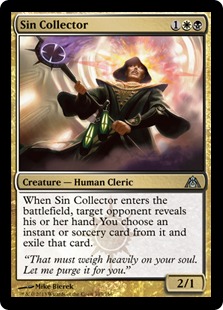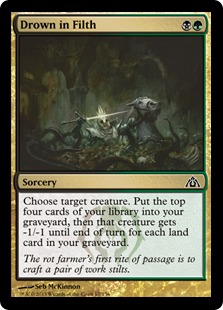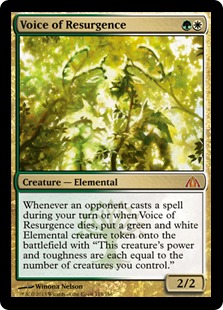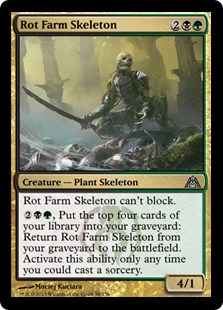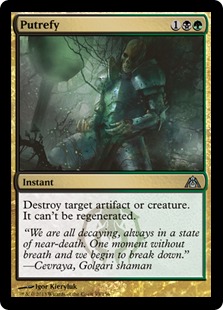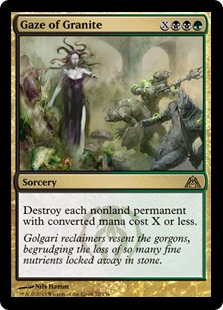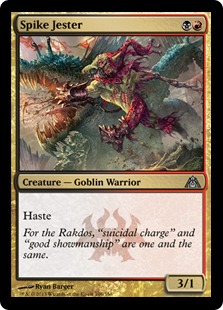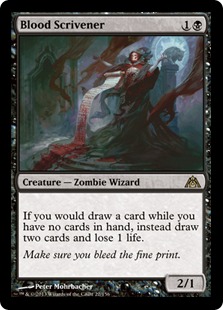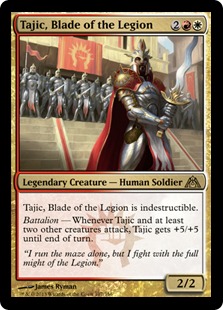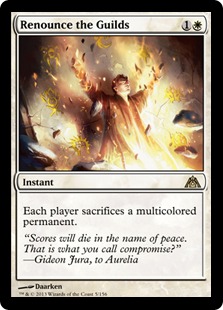There are only 146 new cards in Dragon’s Maze. How much impact could it really have…?
Dragon’s Maze may only be introducing 146 cards to Standard, but it sure has been engineered to be packed with impactful cards. It seems like there are cards for every deck plus the perfect cards for spawning a number of new archetypes, not to mention some powerful tools for shaking up the metagame if it tips too far one way or the other.
This week, we’ll be breaking down Dragon’s Maze and looking at the metagame of the future. The name of the game is figuring out how to use each of the new cards effectively, so arbitrary 1-5 or 1-10 ratings are not nearly as useful as evaluating the rate (how much power do you get compared to the cost) and context (how good is the card in the format to come)?
We’ll start with a look at the existing strategies in Standard and how they are affected by Dragon’s Maze week 1 and what questions need to be asked. Later in the week, we will continue on with a look at the new brews brought to life by Dragon’s Maze.
If we’re going to start with the existing strategies of Standard, we better start with the format’s top dog, Reanimator.
Creatures (21)
- 1 Acidic Slime
- 3 Arbor Elf
- 4 Avacyn's Pilgrim
- 3 Restoration Angel
- 2 Craterhoof Behemoth
- 4 Thragtusk
- 3 Angel of Serenity
- 1 Voice of Resurgence
Lands (23)
Spells (16)

G/W/B Reanimator was already the favored style of graveyard deck, and Dragon’s Maze only reinforces this. There are actually quite a few interesting questions to ask here. First, and possibly most important, what do we do with Sin Collector?
Duress can be extremely powerful, but it’s risky on account of how many key cards it doesn’t hit these days. Additionally, it aspires to one-for-one, sometimes ending up in spots where it misses or is drawn against an opponent with no hand. Despite all this, it is still one of the game’s all-time great sideboard cards, occasionally even crossing over to maindecks.
Sin Collector is very literally a body and a Duress. This means we need to ask ourselves how good of a Duress is it, if we are in the market for a Duress, as well as is it good enough to play because of the body if we didn’t already want a Duress?
Comparing Sin Collector to Duress is really a question of the value of that mana to you versus the body. It’s like a Duress that gives you a 2/1 for 1W tacked on (but no additional card). Is that a good deal? Well, Elvish Visionary is not bad, and Silvergill Adept was fantastic in every format all the way up to Legacy. In a way, Sin Collector is a Silvergill Adept that always draws a Duress. It’s even a Human, which is a pretty fantastic creature type these days!
While Sin Collector is generally at a little higher power level than Duress, this doesn’t mean it straight up obsoletes Duress. In formats where you need to Duress by turn 2, you don’t want to be stuck buying a 2/1 you can’t afford. However, that is pretty far from the Standard world we live in. Standard’s a format where there are a plenty of opponents that will have relatively few noncreature spells at all. The places where Duress is good, you don’t even necessarily want to do it on turn 1 anyway. If Modern stays away from turn 3 combo decks, Sin Collector should be a solid role-player there—a more reliable Tidehollow Sculler.
Sin Collector’s body is actually quite valuable as an anti-planeswalker tool (attacking for two) or a chump blocker, but what makes it really exciting is the sheer volume of synergies it can be a part of. As previously mentioned, it has all the usual Human synergies ranging from Champion of the Parish and Mayor of Avabruck to Cavern of Souls and Angel of Glory’s Rise. The tribal synergies are only the beginning, though. Sin Collector being a 187 at all should be the signal to consider combining it with Restoration Angel.
When we stick Sin Collector on turn 3, we can sculpt our game plan based on the contents of their hand, and take a key Supreme Verdict, Sphinx’s Revelation, or any other key card. Then, when they Think Twice while trying to recover, we can flash down a Restoration Angel and take the supreme Verdict they had been digging to. Incidentally, if Crypt Incursion picks up as a sideboard card (which it will), Restoration Angel + Sin Collector is a great way to snag one.
While Reanimator doesn’t take full advantage of Sin Collector’s synergies, it does feature Restoration Angel tricks and is a deck that cares a lot about key cards. Sin Collector has great chances of being a popular sideboard card here, but the real question is if it might sneak into Reanimator maindecks. I think there’ll be plenty of decks that want to maindeck Sin Collector, to be sure, but is Reanimator one of them?
Drown in Filth, inspired by Hall of Famer Ben Rubin, is as obvious a question to ask as they come. Reanimator has gone back and forth on removal and whether they want a small amount maindeck. Drown in Filth provides a non-zero amount while also supporting the self-mill element of the engine. It may not always be reliable for kill large creatures, but it sure is a great answer to Deathrite Shaman!
I am hesitant to start with too many, as Reanimator is not a strategy that can afford to be overstuffed with reactive cards. Remember, you need a target to even cast Drown in Filth, so you can’t just “cycle” it for the milling (at least not without a little finesse). If the format moves in a direction where spot removal is particularly important, it is totally reasonable to play more of these, but I’d be careful about it as your only removal since it’s not really want you want to play on turn 2. I wonder if the printing of Drown in Filth will increase the number of Evolving Wilds seeing play. Could it be combined with Fetchlands to break through in Modern? It’s a little underpowered for that format, but there is no shortage of cards to combine it with.
Speaking of sideboard options, Voice of Resurgence is another great new one from Dragon’s Maze, though I imagine I am suggesting less than many others will use day 1. Don’t get me wrong, the card is great; I just think it’s easy to play it for the wrong reasons and slightly overhyped. The card is quite strong on raw power, as discussed here. It’s just that we aren’t always going to be in the market for the specific power it provides.
Voice of Resurgence is a Sprouting Thrinax of sorts—a creature good against removal. It’s also a very powerful Defense Grid, punishing opponents that want to interact on your turn. Is Reanimator in the market for either of those?
Maybe.
On the one hand, we have plenty of creatures, so the Elementals Voice of Resurgence makes are of great value (particularly when combined with Lingering Souls). On the other hand, it actually has to go to the graveyard to use its death trigger, so it is another card hosed by Rest in Peace.
I lean towards trying it in moderation, as the card’s raw power is high enough that it could just justify itself from the bodies. Additionally, the format will not yet have had time to adjust, so there won’t be as many Pillar of Flames as there should be and people will still be playing all these Flash decks that won’t know what to do against it.
One creature I am not using in here but could is Rot Farm Skeleton. The card’s not unplayable by any means; it’s just not what Reanimator is looking for. A card having synergy with your deck doesn’t automatically make it belong. There are more than 60 cards with graveyard synergy. We can’t play them all.
Rot Farm Skeleton is pure offensive, with its real value in being found by dredging (Mulch, Grisly Salvage, etc.), fighting removal (keeps coming back), and the ability to further fuel our engine (its own milling). Being found by dredging is great, but is this really better than another Lingering Souls? Maybe, but I lean against. Is fighting removal that important? It could be in the future, no question, but Thragtusk, Restoration Angel, Angel of Serenity, and Unburial Rites all contribute to removal being the least of Reanimator’s worries. The self-mill is respectable, but there is a risk of a the rich get richer type of situation. When everything is going well, you get even more of it!
Wait a minute; didn’t we just see this art? Oh, this isn’t another Rot Farm Skeleton. That’s weird…
Putrefy is certainly a respectable option and will see lots of play in the format as a whole. It’s much weaker in Reanimator since it doesn’t hit Rest in Peace, the most important permanent for Reanimator to get rid of (and why they play all these Acidic Slime). As a result, Abrupt Decay is a better choice (at least week 1).
One new option that actually does get rid of Rest in Peace is Gaze of Granite.
The Golgari sure do have a specific color scheme they are sticking to this set!
Gaze of Granite is certainly expensive (a Pernicious Deed that you have to activate immediately) and as such is just in the same league as Pernicious Deed. Of course, that is miles beyond a reasonable bar for a card, and it does have a few interesting features.
First, unlike Pernicious Deed it can actually hit planeswalkers. It can be a costly way to do it, but it is another out to their ultimates when the going gets rough. Second, Gaze of Granite is a sorcery rather than an enchantment. While Stifle effects aren’t real big in Standard, there are some nice synergies with cards like Augur of Bolas that specifically reward you for having a critical mass of actual sorceries and instants.
Perhaps most importantly, Gaze of Granite is actually legal. It’s not like Pernicious Deed is even a thing people can do, so the real competition is along the lines of Mutilate. If you want a Nevinyrral’s Disk, this is as close as you are going to get in Standard. In my opinion, the most exciting use of the card is to sweep up problematic permanents while keeping your fatty on the table. After all, a Gaze of Granite for four kills the opposing Restoration Angel; Jace, Architect of Thought; Augur of Bolas; and Detention Sphere while letting your Thragtusk live.
[Editor’s Note: Location: Magical Christmasland. Mayor: Chapin, Patrick]
Is it right for Reanimator? It seems a little slow, and we’re really not that in the market for a sweeper. However, it is an option to keep in mind if the format gets flooded with Burning-Tree Emissary decks. Imagine Paul Rietzl gets his way and a fast Boros deck with Rest in Peace is dominating Standard. Gaze of Granite starts to look pretty good in that world!
It’s a pretty big longshot, but another option to consider for Reanimator is the Golgari champion, Varolz, the Scar-Striped.
Reanimator isn’t known for being short on things to spend its mana on, but it’s pretty easy to fill your graveyard with lots of random Thragtusks, Deathrite Shamans, Arbor Elfs, and Restoration Angels. The random +1/+1 counters make for a reasonable back-up plan, but exiling the creatures interferes with Unburial Rites and Angel of Serenity. Additionally, that’s a pretty “fair” game plan.
While Varolz could work in a straight Reanimator deck, where I think it gets really exciting is when combined with cards that let you “cheat” the system such as Boneyard Wurm and Splinterfright—a strategy we’ll explore later this week.
While Reanimator may currently be the deck to beat, it wasn’t always. Rakdos, the deck to beat just three months earlier, took a big hit during Gatecrash. It received almost no new cards while a lot of aggro decks gained powerful tools that made them just better Rakdos decks in the head-to-heads. A lot of the strategies Rakdos preyed on dropped in popularity, and the world just right for it anymore. Could there be a resurgence after Dragon’s Maze? It would take something pretty special.
Aggressive.
Rakdos has long had a reputation for a weakness at the two spot. Gravecrawler and Diregraf Ghoul give Rakdos a respectable quantity of legit threats on all turns of the game, and Geralf’s Messenger, Falkenrath Aristocrat, Hellrider, and Thundermaw Hellkite ensure the high drops are top shelf. What have been missing are two-drops in the same league as these other threats. Knight of Infamy isn’t bad but doesn’t totally mesh, and the second best two-drop is what? Thrill-Kill Assassin? Rakdos Shred-Freak?
Well, Spike Jester changes all of that. Rakdos has often made use of Rakdos Shred-Freak and not hated it. Getting an extra +1 attack for basically no cost? That’s the difference between a Watchwolf and an Elvish Warrior or a Mon’s Goblin Raider and a Savannah Lions.
Spike Jester is certainly beatable. After all, it is just a random one toughness creature that doesn’t draw any cards, can be blocked, and dies to all sorts of removal. That said, if it hits you even a single time, it has generally done its job.
Creatures (27)
- 4 Diregraf Ghoul
- 4 Gravecrawler
- 4 Falkenrath Aristocrat
- 1 Hellrider
- 4 Geralf's Messenger
- 4 Knight of Infamy
- 2 Thundermaw Hellkite
- 4 Spike Jester
Lands (23)
Spells (10)

While I don’t think Spike Jester is enough to catapult Rakdos back to the top of the format, it is enough to breathe new life into the once-great archetype and should certainly be a four-of in any such lists. That it is a Goblin is interesting, and while probably more important for Modern and Legacy, it’s still a trait to keep in mind over the next two years.
Unfortunately, potential Rakdos players are also going to encounter a fair bit of splash hate. Voice of Resurgence ensures there will be more Pillar of Flames than there would have been previously. Reanimator’s dominance means more graveyard hate aimed at combating aggressive decks. Additionally, Far // Away, Renounce the Guilds, Warped Physique, Catch // Release, and Profit // Loss add up to a lot more answers to Falkenrath Aristocrat.
Rakdos really doesn’t gain all that much more from Dragon’s Maze unless you are looking to go a little bigger, where you can find cards like Sire of Insanity. It does have a one oddball possibility to consider in the somewhat overrated Blood Scrivener:
Look, I love drawing cards as much as the next guy and do think Blood Scrivener will find some homes, but traditional Rakdos is probably not the best place for him. Cards like Falkenrath Aristocrat, Hellrider, and Thundermaw Hellkite can add up to a pacing that is not in line with the hellbent mechanic, to say nothing of playing situational removal.
If and when we do go hellbent and Blood Scrivener lives, we built what? An Underworld Connections? Drawing extra cards is always nice, but this isn’t even what Rakdos is looking for. Blood Scrivener wants to be in a deck full of cheap action, a deck full of mostly one- and two-drops. I just don’t see it.
Moving along to the Boros Legion, a card that I think isn’t being talked about nearly enough is its signature card, Tajic, Blade of the Legion.
The Boros champion, Paul, err Tajic is kind of a Geist of Saint Traft type of card, which is to say that it is extremely powerful in a very predictable way. If you don’t play the game it says is going on, it is basically a 7/7 indestructible for four, which is way more powerful than a Magic card is supposed to be.
It hits like a bag of trucks and gives some much-appreciated Supreme Verdict protection. While certainly more appropriate for a more Boros-esque strategy that just wants to beatdown rather than play some combo-y game, Tajic could be part of a Champion of the Parish build of The Aristocrats that just wants to be able to present a durable offense.
Tajic is going to be real nice day 1 before the format adjusts. Eventually, there will be more copies of Far // Away, Liliana of the Veil, Mutilate, Turn // Burn, Drown in Filth, Warped Physique, Detention Sphere, Devour Flesh, Tribute to Hunger, Dead Weight, Renounce the Guilds, and the like.
Speaking of Renounce the Guilds, talk about a big blow to The Aristocrats! One of the strengths of The Aristocrats has been the variety of angles it hits from. It’s resilient and difficult to combat all sides all at once. Cartel Aristocrat has protection from colors, Falkenrath Aristocrat is indestructible, Boros Reckoner is hard to burn or block, and Sorin, Lord of Innistrad is a planeswalker when some can only fight creatures. Renounce the Guilds can hit every single one of these key cards. The good news is that it’s just a one-for-one, but it is a great way to solve hard problems and for very little mana.
One strategy that really doesn’t gain all that much is Naya Blitz. They have some options to consider, to be sure, but they kind of push the deck in a different direction than the all-in assault currently employed. For instance, are you supposed to use Voice of Resurgence?
It is definitely a powerful card, but it’s not really that all-in. It’s just a two power threat for two without haste that can’t be cast by Burning-Tree Emissary. You’re paying for the resilience, but is Naya really equipped to take advantage of the resilience? It is a great weapon against Jund and Supreme Verdict, to say nothing of Flash decks, so perhaps that will justify its existence (even if just as a sideboard card). Where I think Voice of Resurgence will really shine is in a slightly more midrange approach, perhaps with more of a token vibe.
Another sideboard option for Naya decks (and any G/W/x aggro deck) is the new Armadillo Cloak, Unflinching Courage.
While technically worse than Armadillo Cloak (since it can’t be used on your opponent’s creatures in a pinch), Unflinching Courage is a great way to punish opponents without removal that just want to race you. If you and your opponent are just going to be in a slugfest, throw this on a Champion of the Parish and you can really go to town.
Unflinching Courage is a respectable option in a lot of different decks, but it will probably be at its best in Bant Hexproof and more midrange decks that are able to throw it on a giant flier like Thundermaw Hellkite or Rith the Awakener.
Creatures (37)
- 4 Champion of the Parish
- 4 Mayor of Avabruck
- 2 Thalia, Guardian of Thraben
- 4 Lightning Mauler
- 4 Flinthoof Boar
- 4 Boros Elite
- 4 Burning-Tree Emissary
- 4 Experiment One
- 3 Frontline Medic
- 2 Ghor-Clan Rampager
- 2 Tajic, Blade of the Legion
Lands (20)
Spells (3)

One final option to consider for Naya Blitz is the above-mentioned Tajic. It’s a little slow, but seven points of damage is no joke. If we end up taking Naya in a slightly slower direction, it could be exactly what the doctor ordered. I’m not sure Burning-Tree Emissary is trying to hear any of this “slower” nonsense, but I know Lightning Mauler sure does love following up when an opponent Supreme Verdicts away everything but Tajic!
Join me back here Wednesday when we tackle both Jund decks and decks with actual blue cards and then diving into some new decks made possible by Dragon’s Maze. What card are you most excited to build around? What’s the best card in the set? What’s the best card no one’s talking about?
See you then!
Patrick Chapin
“The Innovator”
 |
The first rule of Dimir Guild is you do not talk about Dimir Guild. The second rule of Dimir Guild is you do NOT talk about Dimir Guild. My official response? Izzet and proud… |

